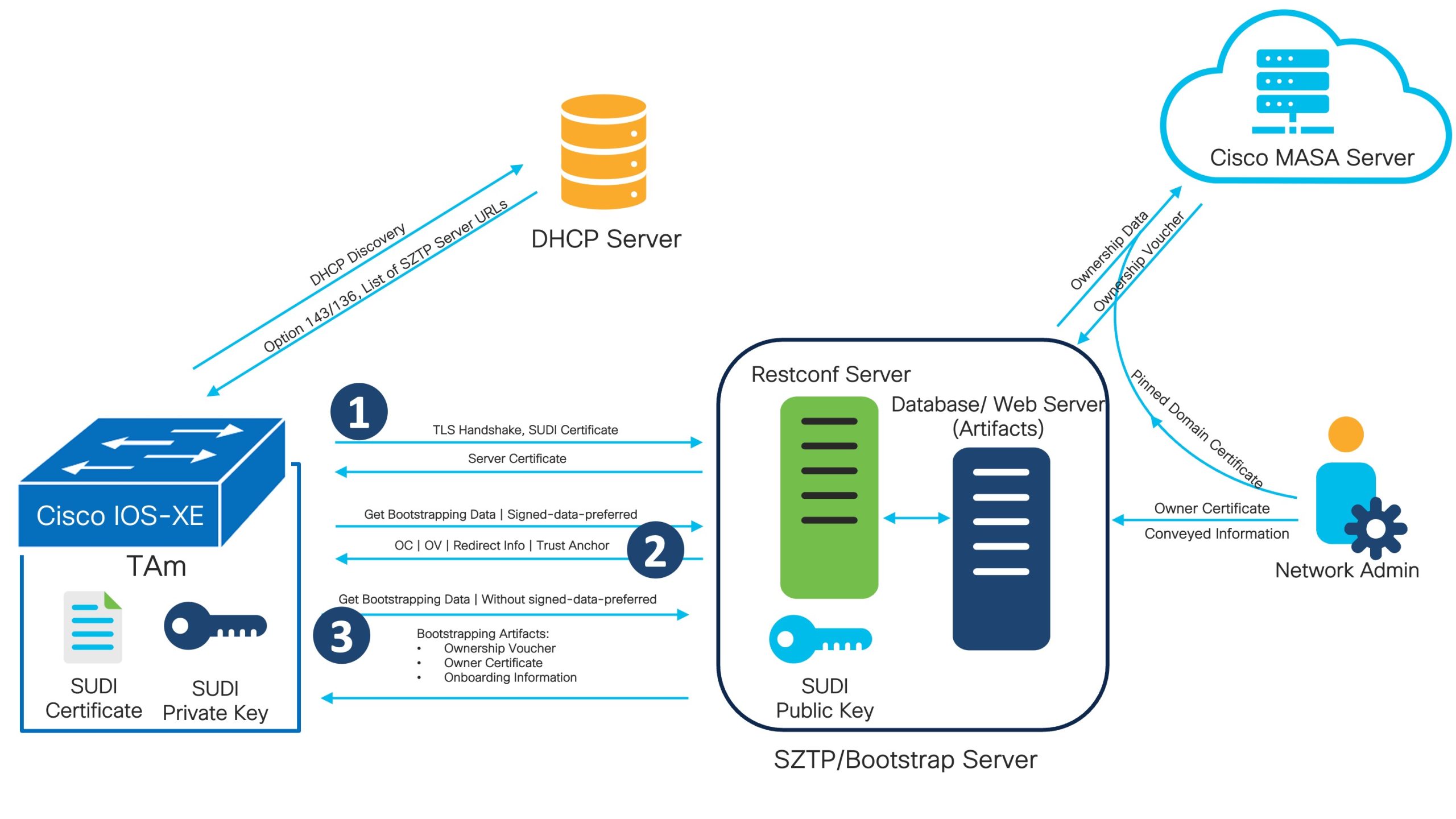In right this moment’s fast-paced and hyper-connected world, gone are the times when deploying community units required sending an professional to every location — a cumbersome, time-consuming, and error-prone course of that brought on important downtime and elevated operational prices. To surmount these obstacles, Cisco gives quite a lot of community orchestrators. These included Cisco Catalyst Heart (previously Cisco DNA Heart), SD WAN Supervisor (previously Cisco vManage), and Meraki Dashboard, which help companies in automating their campus community administration together with Day 0 provisioning. These orchestrators enable community directors to remotely deploy numerous community units shortly and securely, with out requiring any human intervention. This not solely saves money and time but in addition liberates IT division sources, permitting them to redirect their efforts in the direction of different essential areas.
Utilizing Catalyst Heart PnP, Cisco IT was capable of cut back annual deployment prices for some websites by roughly 25%, or greater than $1.6 million. Moreover, upgrading our 285 small and medium-sized places of work with Cisco Catalyst Heart saved 570 man-hours per improve[1].
Along with Cisco community orchestrators for purchasers using a Do-It-Your self (DIY) strategy with homegrown instruments, Catalyst 9000 sequence switches supply assist for an assortment of open standard-based implementations for Day 0 community automation, similar to Preboot eXecution Setting (PXE) and Zero Contact Provisioning (ZTP). So, if you end up nonetheless manually configuring community units, it might be time to contemplate stepping out of the stone age and exploring the advantages of automation.
Day 0 community automation
When delving into the realm of open standard-based Day 0 community automation, it turns into clear that PXE, whereas a helpful method, comes with a set of limitations, similar to solely permitting community units in addition from a network-based supply and never with the ability to ship configurations to units through the PXE workflow. ZTP, alternatively, can be utilized to improve software program pictures and push configuration information, decreasing the possibility of human error and making certain configuration consistency with a purpose to get community units up and working.
Whereas ZTP and PXE are handy for automating the provisioning course of, they could inadvertently expose community units to potential threats. Lack of safe authentication and verification mechanisms through the provisioning course of is without doubt one of the main issues with these strategies. Moreover, ZTP and PXE make the most of HTTP/TFTP to obtain the software program picture or configuration information, that are inherently insecure protocols as a result of they lack encryption. Because of these limitations, these strategies may lead to unauthorized entry to the gadget or a man-in-the-middle assault if the proper safety measures aren’t put in place through the gadget provisioning.
Cyberattacks have elevated
In right this moment’s quickly evolving digital panorama, the place enterprises are present process substantial transformation, cyberattacks have elevated amid the rise of cloud computing, hybrid and multi-cloud networks, and the rise of distant work. In line with the newest IBM Ponemon Institute 2023 Price of Information Breach Examine, the common value of an information breach reached an all-time excessive in 2023 of USD 4.45 million [2]. Moreover, in keeping with ITIC’s 2022 World Server {Hardware} Safety report, 76% of companies cite Information Breaches and Human Error because the main motive of server, OS, software, and community downtime, and the hourly value of downtime has risen to over $300,000[3].
On condition that cybercriminals are continuously devising new strategies to infiltrate networks, the normal safety strategy, which assumes that every part inside the community perimeter is reliable, is not enough. That is additionally true for Day 0 community automation, the place it’s essential to validate the trustworthiness of the newly deployed gadget, bootstrap server, and configurations pushed to the gadget. With out implementing these safety measures, our networks are susceptible to quite a lot of cyberattacks, together with the infamous zero-day exploits. To make sure maximal safety and decrease potential dangers, the Zero Belief precept of “by no means belief, at all times confirm” should be carried out all through all the provisioning course of.
Preserve safety all through the provisioning course of
That is the place Safe Zero Contact Provisioning comes into play. Safe ZTP, as described in RFC 8572, is an enhanced model of ZTP that emphasizes sustaining safety all through the provisioning course of by decreasing the probability of safety breaches. Safe ZTP is a proactive strategy that employs sturdy authentication, a safe boot mechanism, and encrypted communication channels to reinforce the safety posture of a community whereas Day 0 community automation is in place.
How does Safe ZTP work?
Safe ZTP employs three-step validation, together with gadget validation, server validation, and artifact validation, to securely onboard the gadget. The diagram supplied under illustrates the varied steps concerned within the gadget onboarding and provisioning course of inside a safe ZTP framework. Let’s take a better take a look at every of those steps:

1. Gadget Validation
Earlier than onboarding a brand new gadget on the community, it’s essential to make sure that neither the gadget nor its firmware has been tampered with or compromised to forestall provide chain or some other assaults, by which malicious actors try and introduce modified or malicious units into the community. Based mostly on the latest IBM report, 15% of organizations recognized a provide chain compromise because the supply of an information breach [2].Safe ZTP performs gadget authentication previous to provisioning it with a purpose to confirm the integrity and authenticity of a tool and to permit solely licensed units to affix the community.For gadget validation, Safe ZTP makes use of certificate-based authentication the place the gadget sends the Belief Anchor Certificates (often known as a SUDI certificates put in within the gadget through the manufacturing course of) to the Safe ZTP server, and the server validates it with the general public certificates (supplied by the producer) to make sure the gadget’s authenticity.
2. Server Validation
Server validation is one other very important a part of the Safe ZTP. By confirming the server’s identification, the gadget can guarantee that it’s speaking with an uncompromised, reliable server. This prevents unauthorized or malicious servers from intercepting or manipulating the provisioning course of. After verifying the gadget, bootstrap server sends server certificates. The gadget requests bootstrapping information with the flag “signed-data-preferred” after receiving the server certificates, indicating that the gadget doesn’t belief the server. On this case, remember that server validation is non-obligatory in Safe ZTP. If the community administrator decides to carry out server validation (which entitles server to obtain bootstrapping progress report), the server will ship the “redirect-data” with different bootstrapping information to the gadget, offering its personal tackle and the belief anchor. The gadget verifies the server’s certificates and marks it as trusted server after receiving the belief anchor. Right here, if the system administrator opts to not validate the server, the server will as an alternative go on bootstrapping information instead of the “redirect-data”. As well as, the gadget will proceed the bootstrapping course of assuming the server is untrusted.
3. Artifact Validation
Artifact validation is necessary to make sure that the configuration information or software program pictures used to provision community units are genuine and haven’t been tampered with. As soon as the server validation is full (or skipped), the bootstrap server will ship the proprietor certificates, possession voucher, and onboarding info to the gadget as bootstrapping information. Let’s focus on them intently to realize a greater understanding.
- Possession Voucher (OV): The possession voucher artifact validates the proprietor certificates to confirm the identification of the gadget’s proprietor. The gadget manufacture indicators the OV and supplies it to the shopper primarily based on the request. To generate the OV, the shopper should present the pinned-domain-cert and serial variety of the gadget to the Cisco MASA server.
- Proprietor Certificates (OC): Proprietor Certificates is an X.509 certificates that binds an proprietor identification to a public key, which a tool can use to validate signature over the conveyed info artifact. The proprietor certificates additionally holds all intermediate certificates that led to the “pinned-domain-cert” certificates specified within the possession voucher, permitting the OV to validate the OC.
- Conveyed Data/Onboarding Data: Onboarding info supplies information needed for a tool to bootstrap itself and set up safe connections with different methods. Onboarding info specify particulars concerning the boot picture a tool should be working, an preliminary configuration the gadget should commit, and scripts that the gadget should efficiently execute. The onboarding info should be signed by the gadget’s proprietor utilizing OC.
Zero Belief is essential when performing Day 0 provisioning
Along with its many options, Safe ZTP goes past by providing audit trails and monitoring capabilities. This consists of logging all provisioning occasions, configuration modifications, and person actions. By monitoring ZTP actions, community directors can shortly detect any suspicious exercise and take applicable motion.
As we wrap up our dialogue, it turns into clear that Zero Belief can be essential when performing Day 0 provisioning, and Safe ZTP is the easiest way to make sure that zero belief ideas are utilized whereas performing Day 0 provisioning utilizing a Do-It-Your self (DIY) strategy.
With the IOS-XE 17.11.1 launch, customers can now benefit from the safe Zero Contact Provisioning (ZTP) capabilities with Catalyst 9000 sequence switches. This thrilling characteristic aligns with the specs outlined in RFC 8572, making certain a safe and seamless provisioning expertise. For extra particulars about find out how to implement Safe ZTP, please refer the IOS-XE 17.11.1 Configuration Information.
Preserve Studying with these sources
References
- Cisco DNA Heart: Early Outcomes from Intent-based Networking
- Safety, Information Breaches High Reason behind Downtime in 2022
- IBM – Price of a Information Breach Report 2023
Share:

